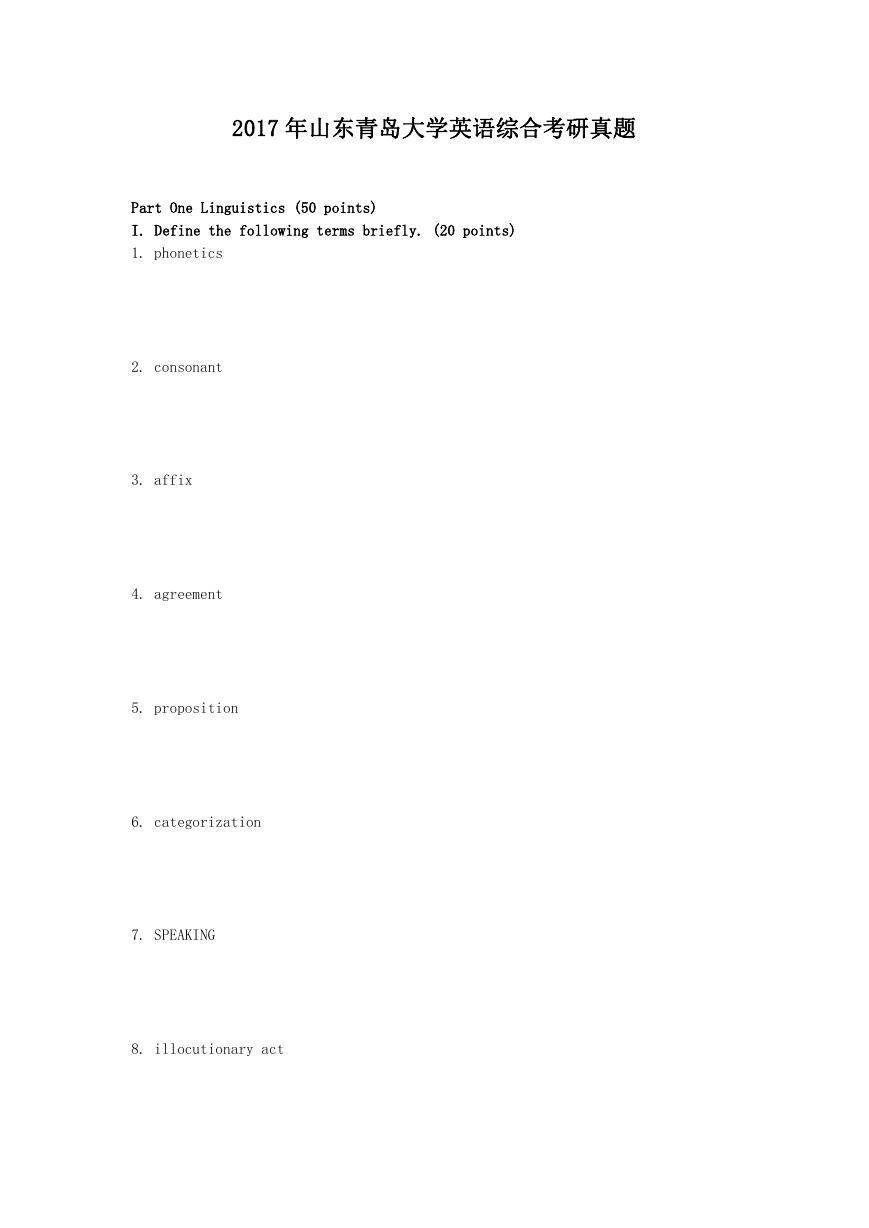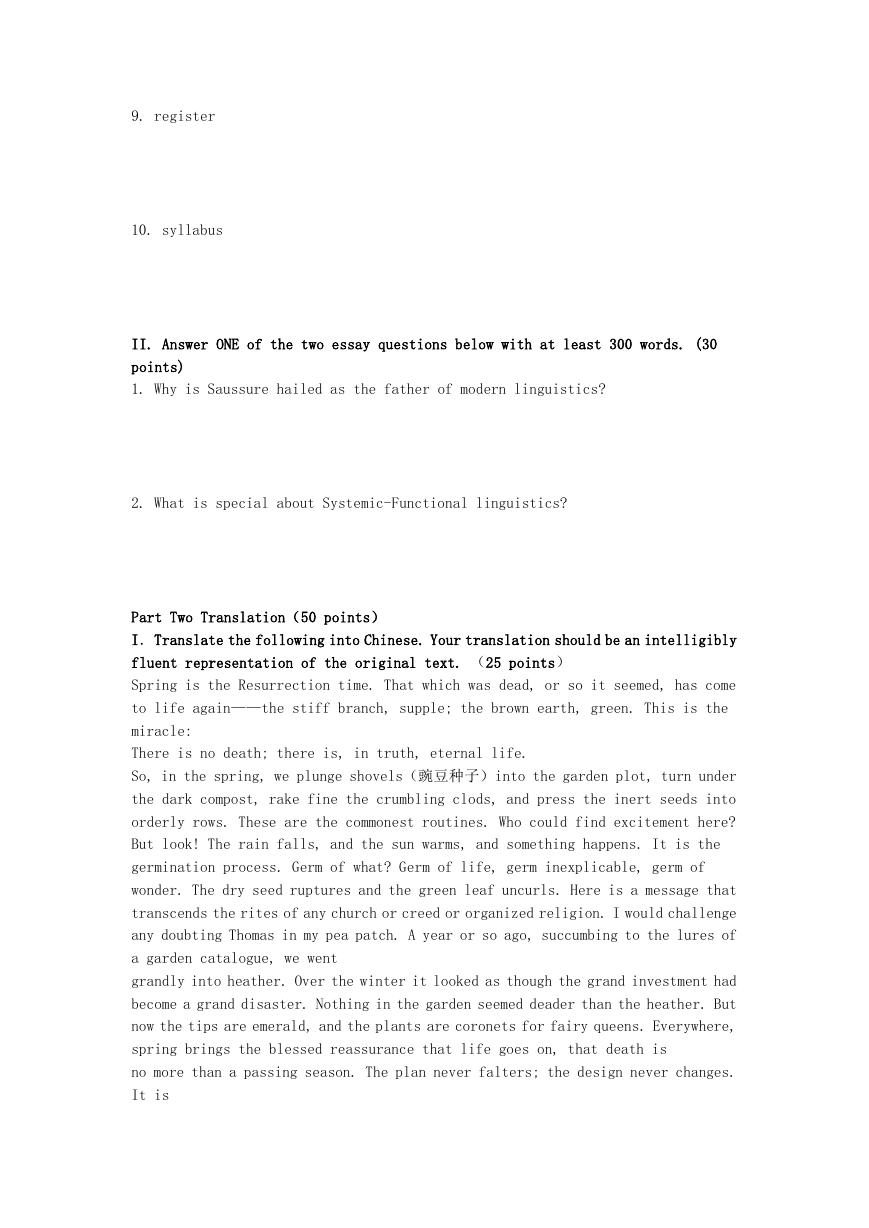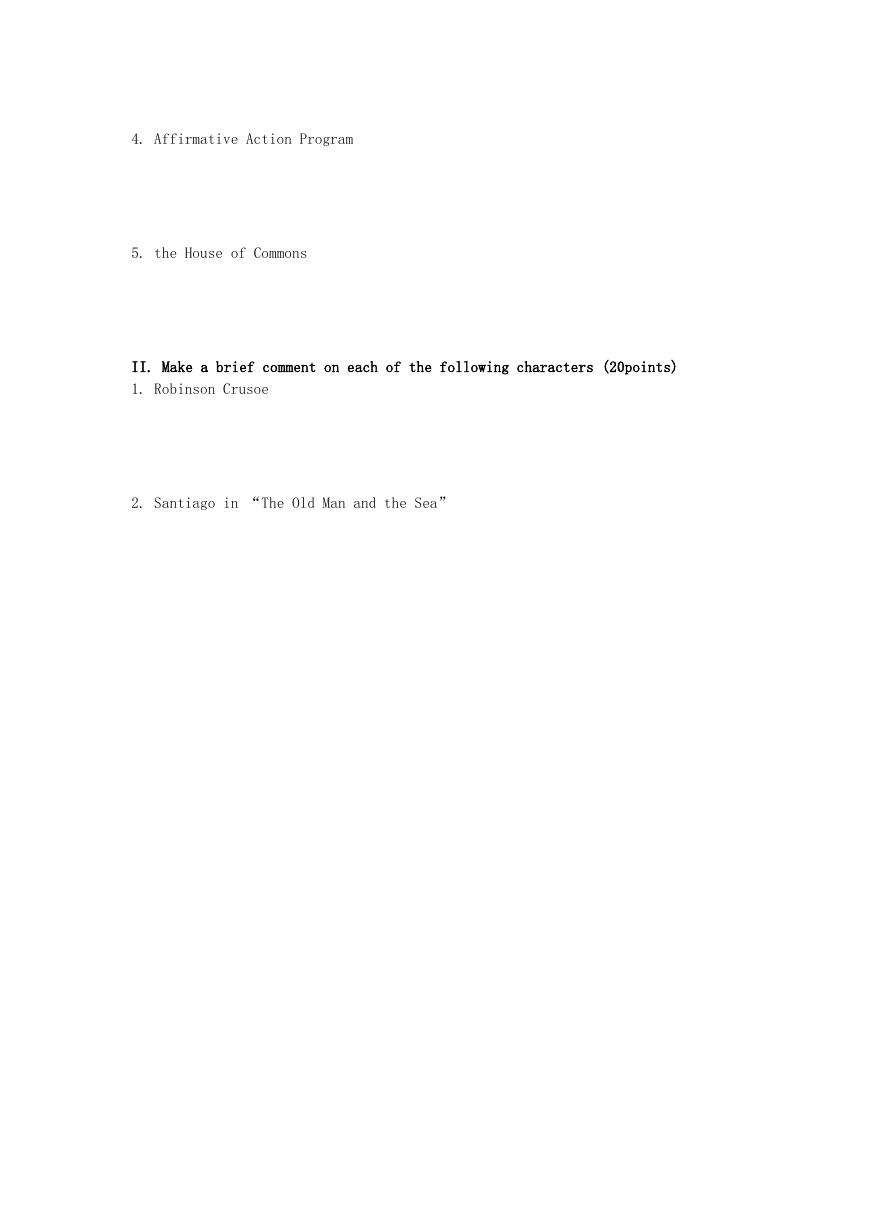2017 年山东青岛大学英语综合考研真题
Part One Linguistics (50 points)
I. Define the following terms briefly. (20 points)
1. phonetics
2. consonant
3. affix
4. agreement
5. proposition
6. categorization
7. SPEAKING
8. illocutionary act
�
9. register
10. syllabus
II. Answer ONE of the two essay questions below with at least 300 words. (30
points)
1. Why is Saussure hailed as the father of modern linguistics?
2. What is special about Systemic-Functional linguistics?
Part Two Translation(50 points)
I.Translate the following into Chinese. Your translation should be an intelligibly
fluent representation of the original text. (25 points)
Spring is the Resurrection time. That which was dead, or so it seemed, has come
to life again——the stiff branch, supple; the brown earth, green. This is the
miracle:
There is no death; there is, in truth, eternal life.
So, in the spring, we plunge shovels(豌豆种子)into the garden plot, turn under
the dark compost, rake fine the crumbling clods, and press the inert seeds into
orderly rows. These are the commonest routines. Who could find excitement here?
But look! The rain falls, and the sun warms, and something happens. It is the
germination process. Germ of what? Germ of life, germ inexplicable, germ of
wonder. The dry seed ruptures and the green leaf uncurls. Here is a message that
transcends the rites of any church or creed or organized religion. I would challenge
any doubting Thomas in my pea patch. A year or so ago, succumbing to the lures of
a garden catalogue, we went
grandly into heather. Over the winter it looked as though the grand investment had
become a grand disaster. Nothing in the garden seemed deader than the heather. But
now the tips are emerald, and the plants are coronets for fairy queens. Everywhere,
spring brings the blessed reassurance that life goes on, that death is
no more than a passing season. The plan never falters; the design never changes.
It is
�
all ordered. It has all been always ordered. Look to the rue anemone(芸香银莲),
if you will, or to the pea patch, or to the
stubborn weed that thrusts its shoulders through a city street. This is how it was,
is
now, and ever shall be, the world without end. In the serene certainty of spring
recurring, who can fear the distant fall?
II. Translate the following into English. Your translation should be an
intelligibly fluent representation of the original text. (25 points)
有些批评家说,中国的文人学士,尤其是诗人,都带着很浓厚的颓废色彩,所以中国的诗文
里,颂赞秋的文字特别的多。但外国的诗人,又何尝不然?我虽则外国诗文念得不多,也不
想开出账来,做一篇秋的诗歌散文钞,但你若去一翻英德法意等诗人的集子,或各国的诗文
的 Anthology 来,总能够看到许多关于秋的歌颂与悲啼。各著名的大诗人的长篇田园诗或
四季诗里,也总以关于秋的部分,写得最出色而最有味。足见有感觉的动物,有情趣的人类,
对于秋,总是一样的能特别引起深沉、幽远、严厉、萧索的感触来的。不单是诗人,就是被
关闭在牢狱里的囚犯,到了秋天,我想也一定会感到一种不能自己的深情;秋之于人,何尝
有国别,更何尝有人种阶级的区别呢?不过在中国,文字里有一个“秋士”的成语,读本里
又有着很普遍的欧阳子的《秋声》与苏东坡的《赤壁赋》等,就觉得中国的文人,与秋的关
系特别深了。可是这秋的深味,尤其是中国的秋的深味,非要在北方,才感受得到底。
秋天,这北国的秋天,若留得住的话,我愿把寿命的三分之二折去,换得一 个三分之一的
零头。
Part Three Culture (50 points)
I. Briefly explain the following terms: (30points)
1. The Bill of Rights of 1689
2. the Commonwealth
3. the Civil Rights Movement
�
4. Affirmative Action Program
5. the House of Commons
II. Make a brief comment on each of the following characters (20points)
1. Robinson Crusoe
2. Santiago in “The Old Man and the Sea”
�








 2023年江西萍乡中考道德与法治真题及答案.doc
2023年江西萍乡中考道德与法治真题及答案.doc 2012年重庆南川中考生物真题及答案.doc
2012年重庆南川中考生物真题及答案.doc 2013年江西师范大学地理学综合及文艺理论基础考研真题.doc
2013年江西师范大学地理学综合及文艺理论基础考研真题.doc 2020年四川甘孜小升初语文真题及答案I卷.doc
2020年四川甘孜小升初语文真题及答案I卷.doc 2020年注册岩土工程师专业基础考试真题及答案.doc
2020年注册岩土工程师专业基础考试真题及答案.doc 2023-2024学年福建省厦门市九年级上学期数学月考试题及答案.doc
2023-2024学年福建省厦门市九年级上学期数学月考试题及答案.doc 2021-2022学年辽宁省沈阳市大东区九年级上学期语文期末试题及答案.doc
2021-2022学年辽宁省沈阳市大东区九年级上学期语文期末试题及答案.doc 2022-2023学年北京东城区初三第一学期物理期末试卷及答案.doc
2022-2023学年北京东城区初三第一学期物理期末试卷及答案.doc 2018上半年江西教师资格初中地理学科知识与教学能力真题及答案.doc
2018上半年江西教师资格初中地理学科知识与教学能力真题及答案.doc 2012年河北国家公务员申论考试真题及答案-省级.doc
2012年河北国家公务员申论考试真题及答案-省级.doc 2020-2021学年江苏省扬州市江都区邵樊片九年级上学期数学第一次质量检测试题及答案.doc
2020-2021学年江苏省扬州市江都区邵樊片九年级上学期数学第一次质量检测试题及答案.doc 2022下半年黑龙江教师资格证中学综合素质真题及答案.doc
2022下半年黑龙江教师资格证中学综合素质真题及答案.doc